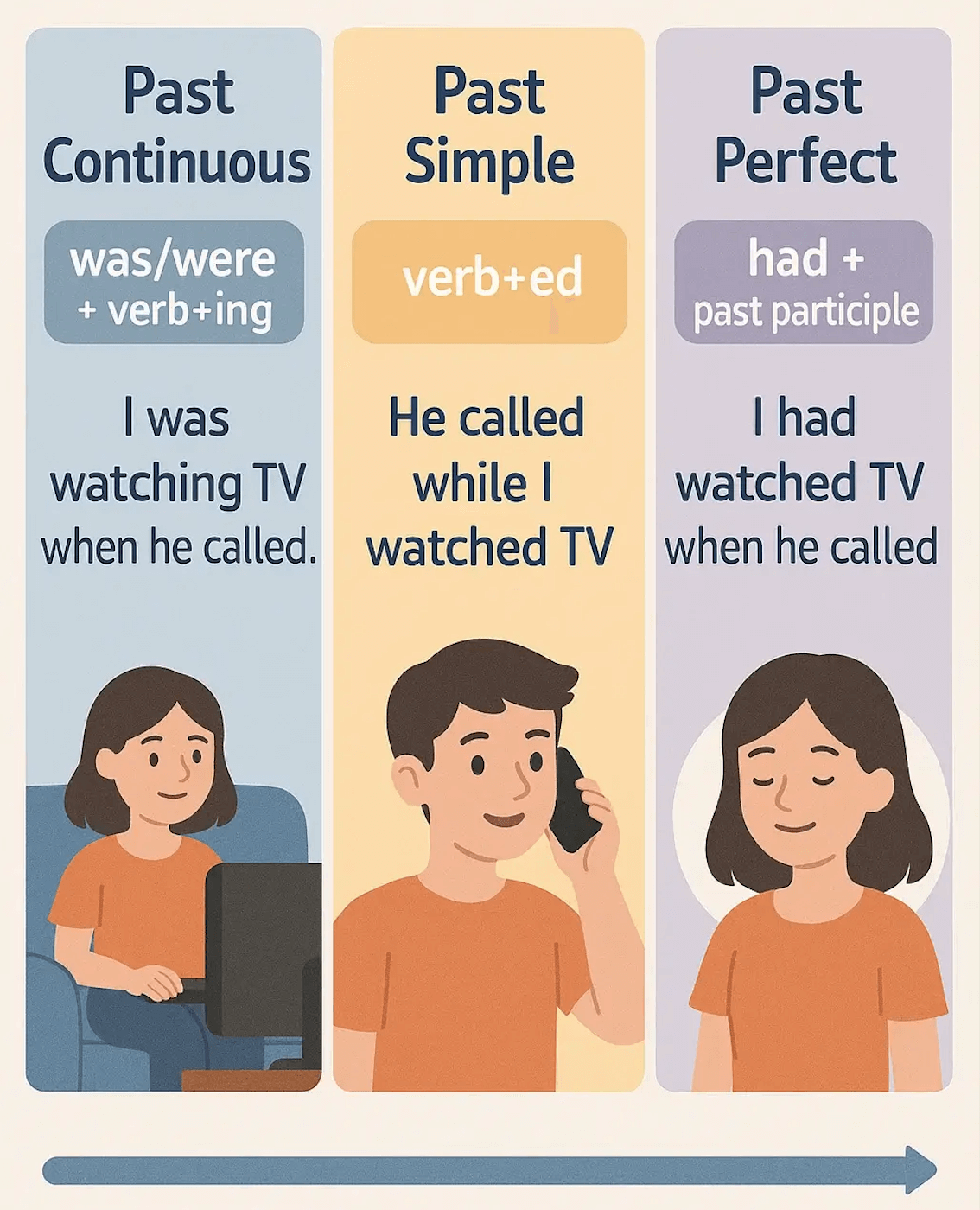Introduction to Past Continuous Tense
The past continuous tense (also called the past progressive tense) is the form we use to talk about actions that were in progress at a particular moment in the past. It provides background, sets the scene, and helps us show that one past action was ongoing when another action happened.
If you can picture a film still from yesterday, the past continuous describes what was happening in that shot.
Throughout this guide you will learn the form (was/were + verb-ing), common uses, spelling rules, time expressions, and how it contrasts with other past tenses. You’ll also see typical mistakes and get quick classroom-ready checks and exercises.
Join over 500+ learners
Join the community for free resources and other learning opportunities.
No spam — only valuable English learning content.
What the Past Continuous Means
When we use the past continuous, we invite the listener to imagine a stretch of time, not just a single event. Compare:
- At 9 p.m. I watched the news. (completed event; start and finish implied)
- At 9 p.m. I was watching the news. (an action in progress at 9 p.m.; we don’t say when it started or finished)
That sense of duration makes the tense ideal for background description, interrupted actions, and two simultaneous actions.
How to Form It (was/were + verb-ing)
The structure is simple:
- Affirmative: Subject + was/were + verb-ing → She was reading; They were cooking
- Negative: Subject + was/were + not + verb-ing → He was not working; We were not waiting
- Yes/No Question: Was/Were + subject + verb-ing? → Was she driving? Were you listening?
- Wh- Question: Wh- word + was/were + subject + verb-ing? → What were you doing at 8?
Spelling Rules for the –ing Form
Because the past continuous relies on the –ing form, correct spelling matters.
- Drop final silent –e: make → making; write → writing.
- Keep –e with –ee/–ye/–oe**:** see → seeing; dye → dyeing.
- Change –ie to –y + ing: lie → lying; tie → tying.
- Double the final consonant in stressed CVC patterns: begin → beginning; run → running; sit → sitting.
- Do not double when the last syllable is unstressed: visit → visiting; open → opening.
Core Uses with Examples
1) Action in progress at a specific time in the past
- At 10 last night, we were revising for the test.
This tells the listener what was happening around that clock time.
2) Two longer actions happening at the same time
- While I was cooking, my flatmate was cleaning the kitchen.
While/As introduce background activities that overlap.
3) Background setting in a narrative
- The wind was blowing, traffic was crawling, and people were hurrying home.
Writers use it to paint the scene before a key event arrives.
4) Interrupted action (past continuous + past simple)
- I was driving home when a dog ran into the road.
The past continuous shows the ongoing background; the past simple shows the sudden, shorter interruption.
5) Polite enquiries and softened statements
- I was wondering if you could help me.
This fixed expression uses a normally stative verb (wonder) in the continuous to sound less direct and more polite.
6) Temporary habits and repeated actions around a past period
- During lockdown, I was jogging every morning.
The activity felt temporary and repeated for a while, not a permanent routine.
7) Plans that did not happen (often with “was going to be + V-ing”)
- We were meeting at six, but the train was cancelled.
This frames a plan as something expected to be in progress before circumstances changed.
Time Expressions You’ll Hear
Typical markers include at 8 a.m., at that moment, yesterday evening, all day, the whole afternoon, while, as, when (for the interruption), during, and at the time. In British English speech, while and as are frequent for overlapping background actions: As I was crossing the road, I was thinking about dinner.
Past Continuous vs Past Simple (and Past Perfect)
It helps to decide whether the action is a background process or a finished event.
- Background process → past continuous: I was reading when you called.
- Finished event → past simple: I read two chapters last night.
- Earlier completed action before another past point → past perfect: I had read two chapters before the film started.

Use our Dictionary
Don't know a word? Use our fun, free dictionary! Enter a word and you will see the meaning, pronunciation with an audio example, example sentence, and (hopefully) a great image to match!
Try for freeStative Verbs and the Continuous
Many stative verbs (verbs of state, not action) rarely appear in continuous forms because they describe conditions rather than activities: know, believe, like, love, need, prefer, understand, seem, belong. We usually say I knew the answer, not I was knowing. There are exceptions in idiomatic or polite forms (I was hoping… / I was wondering…), but as a rule teach learners to use the past simple for most stative meanings.
Passive Voice in the Past Continuous
Passive forms are possible and common with processes:
- was/were being + past participle → The road was being repaired when we arrived.
This emphasises the ongoing process rather than the doer. Avoid overuse; the passive continuous can feel heavy in style.
Pronunciation and Rhythm Tips
Connected speech helps fluency in British English:
- was often weakens to /wəz/; were to /wə/ before a consonant.
- The –ing ending is /ɪŋ/; avoid pronouncing a hard “g”.
- In questions, the auxiliary carries the stress: “Were you watching?”
Typical Learner Mistakes (and how to fix them)
- Using past simple for an action-in-progress
❌ At 7 p.m. I ate. → ✅ At 7 p.m. I was eating. - Omitting the auxiliary
❌ She listening to music. → ✅ She was listening to music. - Using “when” heavily with two long actions
Acceptable but heavy: When I was cooking, he was cleaning → Better: While I was cooking, he was cleaning. - Continuous with stative verbs
❌ I was knowing the answer. → ✅ I knew the answer. - Confusing simultaneous and interrupted actions
Learn the pattern: past continuous (background) + past simple (short interruption). - Mis-spelling –ing forms
Re-check drop e, –ie → –y, and double the final consonant rules.
Style and Register
In conversational British English, the past continuous is friendly and descriptive. It softens tone in customer service or emails: I was hoping to confirm your booking. In storytelling, it keeps the focus on atmosphere: It was raining, people were queuing, buses were splashing past. In reports or formal writing, prefer past simple or past perfect for sequences of completed steps, and reserve past continuous for genuine processes in progress.
Mini Checklist (for quick classroom revision)
- Do I need background rather than a completed event? → Use past continuous.
- Is there an interruption? → Use past continuous + past simple.
- Are both actions long and overlapping? → Use while/as + past continuous for both.
- Is the verb stative? → Use past simple instead.
- Is my –ing spelling correct? → Check the five rules above.
Short Practice You Can Do Now
Rewrite using the past continuous where appropriate:
- At 6 p.m. I cook dinner. → At 6 p.m. I was cooking dinner.
- She read when the alarm rang. → She was reading when the alarm rang.
- They clean while we cook. → They were cleaning while we were cooking.
Conclusion
The past continuous tense—was/were + verb-ing—is your tool for describing ongoing past actions, overlapping activities, and background scenes, and for showing a short interruption with the past simple. Master the spelling of the –ing form, learn the common time expressions, avoid stative-verb pitfalls, and your stories, emails, and conversations will immediately sound more natural and precise.
👉 Continue exploring our grammar articles for more guides on pronouns and their correct usage:
Past Continuous Tense Explained with Examples
Present Simple vs Present Continuous
Future Perfect Tense Made Easy
Countable vs Uncountable Nouns
Comparatives and Superlatives Exceptions
Master Tenses and Boost Your Vocabulary
Learn grammar in context and expand your IELTS vocabulary with 1000 bilingual flashcards designed for Band 7.5+.
Get the FlashcardsGlossary of Key Terms
- Tense (noun) — a verb form that shows time.
- Auxiliary verb (noun) — a helper verb (e.g., was, were) used to build tenses.
- Continuous aspect (noun) — shows an action in progress over time.
- Stative verb (noun) — a verb describing a state (e.g., know, like), not usually used in continuous forms.
- Clause (noun) — a group of words with a subject and a verb.
- Interruption (noun) — a shorter action that stops or affects a longer action.
- Timeline (noun) — a visual line showing when actions happen.
- Affirmative (adjective) — a positive statement (not negative or a question).
- Negative (adjective) — a statement with not.
- Question form (noun) — the word order used to ask something.
Comprehension Practice
Questions
- Which pattern forms the past continuous?
a) have/has + past participle
b) was/were + verb-ing
c) verb + ed - Choose the most natural sentence for an action in progress:
a) At 9 p.m. I watched TV.
b) At 9 p.m. I was watching TV.
c) At 9 p.m. I am watching TV. - True or False: We usually avoid stative verbs like know in the past continuous.
- Fill the gap: We ______ (walk) home when it started to rain.
- Which pair best shows an interrupted action?
a) I was cooking and I was cleaning.
b) I cooked when I cleaned.
c) I was cooking when the timer rang.
Answers
- b
- b
- True
- were walking
- c
Join over 500+ learners
Join the community for free resources and other learning opportunities.
No spam — only valuable English learning content.
